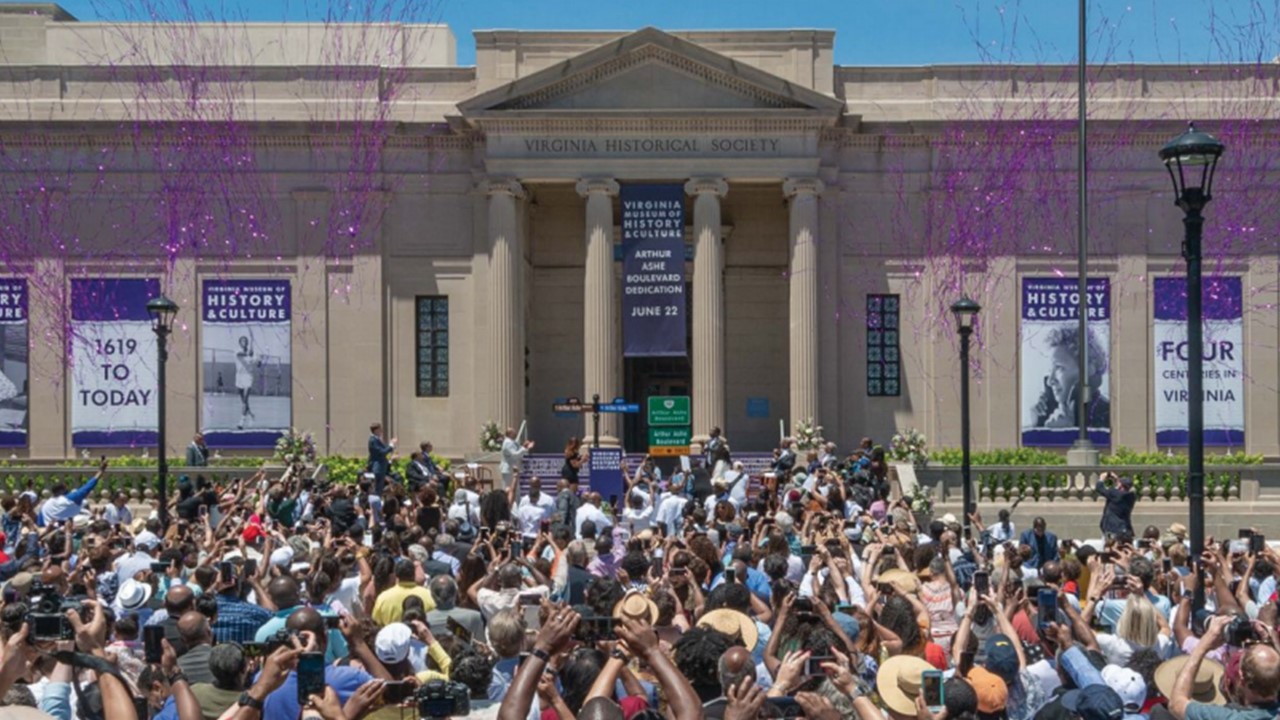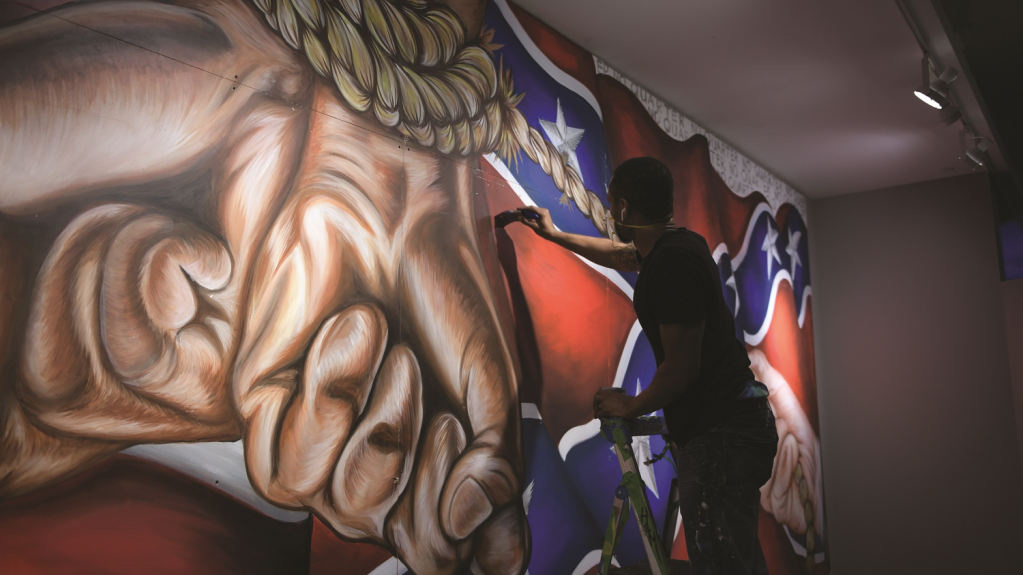
This article originally appeared in the November/December 2020 issue of Museum magazine, a benefit of AAM membership.
Audio: Listen to an audio recording of this article.
The Virginia Museum of History & Culture is reimagining how it serves its African American community.
“My parents told me this wasn’t a place for people like me. . . .”
This wasn’t the first time I had heard some variation of this, but it carried particular weight on this day. After a hug and a smile, the kind woman who said it to me walked up the historic front steps of the museum and through the front door.
On June 22, 2019, the Virginia Museum of History & Culture (VMHC) welcomed the largest and most diverse audience for a museum event in its long history. Thousands of people from Richmond, across the Commonwealth of Virginia, and well beyond crowded onto the museum’s front lawn for the dedication of Arthur Ashe Boulevard—a new name for the prominent Richmond avenue that features the Virginia Museum of Fine Arts and the VMHC, among other nearby attractions.
Stepping out of our comfort zone, we had joined the Ashe family and other local voices in advocating (a first for us) for this important name change. This roadway intersects Monument Avenue, where a statue of Stonewall Jackson once stood, and ends at the city-owned tennis courts where, in a segregated Richmond, Ashe was originally denied access. Symbols and names matter.
On this hot June day, the museum hosted a celebration featuring members of the Ashe family, civil rights icon Congressman John Lewis, and other members of the Congressional Black Caucus, including its chair, Congresswoman Karen Bass. Virginia politicians, including Senator Tim Kaine, Congressmen Don McEachin and Bobby Scott, and Governor Ralph Northam participated as well. They gathered not only to commemorate the life and legacy of humanitarian and tennis champion Arthur Ashe Jr., a Virginia native, but also to mark the 400th anniversary of the arrival of enslaved Africans in English North America at Point Comfort, Virginia—the topic of a commemorative exhibition at the museum that began its run that afternoon.
Undoubtedly, there was a third theme in the air that day as well: the oldest cultural organization in Virginia was making its belated debut to a new audience, the city’s Black residents, about half of Richmond’s population. This was a historic moment, a long time in the making and the culmination of many timely and strategic steps.
“There are many who avoided this building right here behind me,” said David Harris, Jr., Arthur Ashe’s nephew, at the event. “Today I want you to consider this building is now fully integrated. . . . We are going to partner with you and bring you . . . different faces, peoples, ideals, and thoughts to this building to be a beacon to the world.”
A Long History
Founded in 1831, the Virginia Historical Society—the historic name of the VMHC—is one of the oldest such organizations in the nation. Chief Justice John Marshall was its first president and President James Madison its first member. In nearly 190 years of operation, the museum has amassed more than nine million items in its collection, now housed at the museum’s approximately 250,000-square-foot headquarters in the state’s capital.
The historical society, like so many across the nation and particularly in the South, not only preserves history, but has its own extensive and often complicated institutional story. At its founding just 55 years after the signing of the Declaration of Independence, the society was built with the future in mind but led by and focusing on the few. Nonetheless, it formed a founding-era collection featuring many national treasures.
The VMHC’s campus speaks to another element of its complicated past. After years of moving from one temporary home to the next and dodging the destruction of the Civil War, the historical society acquired a grand edifice in what was then the outskirts of Richmond for its permanent home. Built in 1912 by the Confederate Memorial Association (CMA) on land previously used as a veterans camp for aging Confederate soldiers, the structure was meant to rival Grant’s Tomb in New York. In many ways, it was a home to perpetuate the Lost Cause by glorifying the Confederacy and rewriting the narrative of the Civil War and its aftermath.
Not long after the building’s completion, however, the CMA was faltering. The historical society seized the opportunity and subsumed the CMA and its collections. While we gained a new and sizeable home, we have also, in some measure, carried their “baggage” ever since. The “Battle Abbey,” as it was called for decades, has largely blended into the much larger mass of the museum complex—it is a small fraction of the current facility. Its Confederate portraits, busts, and flags are no longer on display, but its history remains.
Over the past several decades, museum leadership inspired and implemented significant advances in the organization’s priorities and programming—guiding it to be far more public-facing than ever before. Good work and good intentions brought many impressive exhibitions and worthy projects to tell more diverse stories, like “Unknown No Longer,” a massive, ongoing research effort to scour through hundreds of thousands of archival materials to reveal the names and stories of enslaved Virginians previously neglected from public record.
However, our future requires us to do more—to accelerate the pace of progress and to take full advantage of past accomplishments for even greater transformation. Virginia deserves a history museum that welcomes and represents all. This is more obvious and important at this time and in this place than perhaps ever before.

A Work in Progress
When I arrived in 2017, despite the efforts of many talented and dedicated people, museum attendance was inconsistent and shrinking overall. Even with a robust donor base, the museum’s finances were strained by unsustainable endowment draws, and debt was an albatross. We still had a persistent public perception problem directly connected to our institutional history.
We needed to reimagine and reintroduce ourselves. We began listening—to people who knew us, people who thought they knew us, and people who didn’t—and planning with care. What we did next needed to be informed, sincere, and persistent.
Our planning effort, which lasted the better part of a year, resulted in change that was more far-reaching than we anticipated. Our new strategy, focused on inclusivity and relevance, articulated the type of place we aspire to be and that our greater community desires. Key themes of engagement and convening required us to rebuild and restructure. Over about two years, some two-thirds of our staff changed; all but one member of our leadership team was new.
It also became clear during this process of evolution that even our name was incongruous with our path. Beyond the simple sense of exclusivity brought by the term “society,” we needed an obvious indication that times were changing. We announced our new name in 2018, which along with a largely new team and purposeful new programs, formed a fresh brand and a pivot point.
Long-term success, in part, will come from a programmatic portfolio and a team that reflects our community in nearly every way possible. There are currently too few people of color on our staff and board, but we are making progress on both fronts. We hope, for example, that a partnership with nearby Virginia Union University, a historically Black university, will provide a local pipeline for students interested in museum and library work.
“Now we must keep our momentum alive and thoughtfully seize upon the cautious optimism of our new and growing Black audience. ”
In commemoration of the 400th anniversary of the arrival of the first enslaved Africans in British North America, the VMHC mounted “Determined: The 400-Year Struggle for Black Equality” to examine the history of Black Americans as they fought for freedom, equal justice, and access to opportunities. The president of Virginia State University, another historically Black university, now sits on our Board of Trustees and nominating committee. We have also changed the way we recruit staff by increasing our spending with media outlets with substantial Black readership/listenership.
Partnerships have also been an essential part of our growth by informing our progress, building trust and awareness, and improving our programming. With a goal of mutuality, we’ve begun collaborating with, hosting, and even directing funds to, and in other ways supporting, community groups, including those focused on racial justice and Black history and culture.
Until recently, we’ve had little or no formal collaboration with the nearby Black History Museum & Cultural Center of Virginia. Now, we have a long-term partnership agreement to share and care for their collections. We are dedicating VMHC staff support over several years to catalog, rehouse, digitize, and securely store the bulk of the Black History Museum collection—a longstanding goal of theirs. They will always maintain ownership, but we will have shared use of their collections (and they of ours) and will jointly share the digital assets created. This may be the very definition of mutuality, a win-win for both organizations.
This year we added a new management position within the president’s office to seek and nurture partnerships and community engagement. We will also begin a new program that allows our staff to dedicate a portion of their paid work time each month to support other nonprofits. We hope this ambassador program will continue to spread awareness of our aspirations, humanize us, and inspire new and lasting connections. And, while it may sound unrelated, we worked with the Richmond City Council to become a new polling place—another way to open our doors to all community members.
Building relationships, trust, and awareness is but one part of our work. Our programming and collections, of course, must be compelling and relevant too. Proactively seeking collections related to underrepresented Virginians is essential, so we recently created a new curatorial role devoted entirely to this endeavor.
The major exhibition we opened on June 22, 2019, “Determined: The 400-Year Struggle for Black Equality,” resulted in the highest and most diverse museum attendance in our history—an overall annual attendance increase of some 50 percent over our historical average. Through the advisory group of statewide scholars and community leaders from diverse racial backgrounds that oversaw its planning and design, we also gained many new and helpful friends.
This past summer, “Mending Walls,” a pop-up display of local mural artists reflecting on the history being made right now, was inspired by the graffiti on boarded windows and building walls amid protests and unrest in Richmond. It is an example of our willingness to be nimble (we planned and implemented this in about a week), listen to what is happening around us, and share authority. Young and diverse artists found a blank canvas on our gallery walls for both their art and their own interpretation.
What’s Next
None of the work we have done, and are doing, is particularly groundbreaking, but, as a whole, and applied consistently and with sincerity, it has set us on an exciting path that many in our community and across our state would not have expected. It is a path of greater mission fulfillment and public service. It has also led to new financial stability, via growth in visitation and membership, and a new sense of hopefulness and vibrancy.
Now we must keep our momentum alive and thoughtfully seize upon the cautious optimism of our new and growing Black audience. To that end, we are taking what we’ve learned in the past three years to inform a $30 million programmatic expansion and renovation of the museum that will open up our building—literally in some cases—and provide more space for public programming and community convening.
This is not a success story. This is a work in progress—and may always be. But it is work worth doing.
Resources
Highlights video of the Arthur Ashe Boulevard dedication ceremony virginiahistory.org/Asheblvd
Jamie O. Bosket is president and CEO of the Virginia Museum of History & Culture in Richmond.







